ISBN-3-86522-085-1
Order No. 1 987 722 146
AA/PDT-04.05-En
The Bosch Yellow Jackets Edition 2005
Expert Know-How on Automotive Technology
Safety, Comfort and Convenience Systems
Driving Stability Systems
Æ
• Electronic Stability Program (ESP)
• Antilock Braking System (ABS)
• Traction Control System (TCS)
• Automatic Brake Functions
Automotive Engineering
s
t
e
k
c
a
J
w
o
l
l
e
Y
h
c
s
o
B
e
h
T
s
m
e
t
s
y
S
y
t
i
l
i
b
a
t
S
g
n
v
i
r
i
D
l
y
g
o
o
n
h
c
e
T
e
v
i
t
o
m
o
t
u
A
n
o
w
o
H
w
o
n
K
-
t
r
e
p
x
E
2005
The Program
Order Number
ISBN
Automotive Electrics/Automotive Electronics
Motor-Vehicle Batteries and Electrical Systems
Alternators and Starter Motors
Automotive Lighting Technology, Windshield
and Rear-Window Cleaning
Automotive Sensors
Automotive Microelectronics
1 987 722 143
1 987 722 128
3-934584-71-3
3-934584-69-1
1 987 722 176
1 987 722 131
1 987 722 122
3-934584-70-5
3-934584-50-0
3-934584-49-7
Diesel-Engine Management
Diesel-Engine Management: An Overview
Electronic Diesel Control EDC
Diesel Fuel-Injection System Common-Rail
Diesel Fuel-Injection Systems
Unit Injector System/Unit Pump System
1 987 722 179
Emissions-Control Technology for Diesel Engines 1 987 722 141
1 987 722 144
Distributor-Type Diesel Fuel-Injection Pumps
Diesel In-Line Fuel-Injection Pumps
1 987 722 137
1 987 722 138
1 987 722 135
1 987 722 142
3-934584-62-4
3-934584-47-0
3-86522-030-4
3-934584-41-1
3-86522-081-9
3-934584-65-9
3-934584-68-3
Gasoline-Engine Management
Emissions-Control Technology
for Gasoline Engines
Gasoline Fuel-Injection System K-Jetronic
Gasoline Fuel-Injection System KE-Jetronic
Gasoline Fuel-Injection System L-Jetronic
Gasoline Fuel-Injection System Mono-Jetronic
Ignition Systems for Gasoline Engines
Gasoline-Engine Management:
Basics and Components
Gasoline-Engine Management:
Motronic Systems
Safety, Comfort and Convenience Systems
Conventional and Electronic Braking Systems
ACC Adaptive Cruise Control
Compressed-Air Systems for Commercial
Vehicles (1): Systems and Schematic Diagrams
Compressed-Air Systems for Commercial
Vehicles (2): Equipment
Safety, Comfort and Convenience Systems
Audio, Navigation and Telematics in the Vehicle
Driving Stability Systems
1 987 722 102
1 987 722 159
1 987 722 101
1 987 722 160
1 987 722 105
1 987 722 130
3-934584-26-8
3-934584-27-6
3-934584-28-4
3-934584-29-2
3-934584-30-6
3-934584-63-2
1 987 722 136
3-934584-48-9
1 987 722 139
3-934584-75-6
1 987 722 103
1 987 722 134
3-934584-60-8
3-934584-64-0
1 987 722 165
3-934584-45-4
1 987 722 166
1 987 722 150
1 987 722 132
1 987 722 146
3-934584-46-2
3-934584-25-X
3-934584-53-5
3-86522-085-1
The up-to-date program is available on the Internet at:
www.bosch.de/aa/de/fachliteratur/index.htm
�
Reproduction, duplication and translation of this
publication, either in whole or in part, is permis-
sible only with our prior written consent and
provided the source is quoted.
Illustrations, descriptions, schematic diagrams
and the like are for explanatory purposes and
illustration of the text only. They cannot be used
as the basis for the design, installation, or speci-
fication of products. We accept no liability for
the accuracy of the content of this document
in respect of applicable statutory regulations.
Robert Bosch GmbH is exempt from liability,
Subject to alteration and amendment.
Printed in Germany.
Imprimé en Allemagne.
1st edition, April 2005.
English translation of the 1st German edition
dated: October 2004
(1.0)
왘 Imprint
Published by:
© Robert Bosch GmbH, 2005
Postfach 1129,
D-73201 Plochingen.
Automotive Aftermarket Business Sector,
Department AA/PDT5.
Product Marketing, Diagnostics &
Test Equipment.
Editorial staff:
Dipl.-Ing. Karl-Heinz Dietsche,
Dipl.-Phys. Maria Klingebiel,
Dipl.-Ing. Ralf Müller.
Authors:
Dipl.-Ing. Friedrich Kost
(Basic Principles of Vehicle Dynamics),
Dipl.-Ing. Heinz-Jürgen Koch-Dücker
(Antilock Braking System, ABS),
Dr.-Ing. Frank Niewels and
Dipl.-Ing. Jürgen Schuh
(Traction Control System, TCS),
Dipl.-Ing. Thomas Ehret
(Electronic Stability Program, ESP),
Dipl.-Ing. (FH) Jochen Wagner
(Automatic Brake Functions),
Dipl.-Ing. (FH) Ulrich Papert
(Wheel-Speed Sensors),
Dr.-Ing. Frank Heinen and
Peter Eberspächer
(Hydraulic Modulators)
and the editorial team in co-operation with
the responsible technical departments at
Robert Bosch GmbH.
Unless otherwise indicated, the above are
employees of Robert Bosch GmbH, Stuttgart.
Robert Bosch GmbH�
Driving Stability Systems
Robert Bosch GmbH
Robert Bosch GmbH�
78 Sensors
78 Automotive applications
80 Wheel-speed sensors
84 Hall-effect acceleration sensors
86 Micromechanical yaw-rate sensors
88 Steering-wheel-angle sensors
90 Hydraulic modulator
90 Development history
91 Design
94 Pressure modulation
98 Technical terms and acronyms
98 Technical terms
101 Acronyms
Text boxes by editorial staff
51 Basic principles of automotive
control engineering
65 Single-track model
77 Directional stability
79 Miniatures
85 Bosch test center at Boxberg
93 ABS versions
97 Development of hydraulic
modulators
왘 Contents
4 Motor-vehicle safety
4 Safety systems
6 Basics of vehicle operation
14 Basic principles of vehicle
dynamics
14 Tires
17 Forces acting on a vehicle
24 Dynamics of linear motion
26 Dynamics of lateral motion
28 Antilock Braking System (ABS)
28 System overview
30 Requirements placed on ABS
31 Dynamics of a braked wheel
32 ABS control loop
36 Typical control cycles
44 Traction Control System (TCS)
44 Tasks
44 Function description
46 Structure of traction control
system (TCS)
47 Typical control situations
48 Traction control system (TCS)
for four wheel drive vehicles
52 Electronic Stability Program
(ESP)
52 Requirements
53 Tasks and method of operation
54 Maneuvers
62 Closed-loop control system and
controlled variables
68 Automatic brake functions
68 Overview
70 Standard function
72 Additional functions
Robert Bosch GmbH�
Today’s passenger cars are equipped with powerful and reliable braking systems that pro-
vide excellent braking power even at high speeds. But even the best braking system can-
not prevent a driver from reacting incorrectly and applying too little or too great a force
to the brake pedal when driving on poor road conditions or when taken by surprise.
The Bosch antilock braking system (ABS), the first to be developed for series pro-
duction, ensures that vehicles remain steerable and maintain directional stability even
during emergency braking. The ABS system is also the foundation for systems such as
the traction control system (TCS), electronic stability program, (ESP) and other sup-
port systems.
The traction control system (TCS) prevents the driven wheels from spinning when
setting off and accelerating. The ESP (electronic stability program) vehicle dynamics
control system ensures stability and keeps the vehicle on course in every conceivable
driving situation by means of rapid intervention in the engine and braking systems.
ESP therefore supplements ABS and TCS by detecting even the slightest rotational
movements of the vehicle and correcting driving faults. The ESP intervention often
goes unnoticed by the driver.
This booklet provides detailed information on the current state-of-the-art in the field
of driving stability systems. It details the design and functioning principles of these
systems and their components. Additional functions, such as the Brake Assist and
Hill Hold Control that are increasingly integrated in these systems to ensure additional
safety and convenience, are also described. The booklet offers a structured overview
of the topics.
A series of detailed illustrations accompanying the written texts help to clarify
the sometimes complex descriptions and interrelationships making them easy to
understand.
Robert Bosch GmbH�
4
Motor-vehicle safety
Safety systems
Motor-vehicle safety
In addition to the components of the drive-
train (engine, transmission), which provide
the vehicle with its means of forward mo-
tion, the vehicle systems that limit move-
ment and retard the vehicle also have an im-
portant role to play. Without them, safe use
of the vehicle in road traffic would not be
possible. Furthermore, systems that protect
vehicle occupants in the event of an accident
are also becoming increasingly important.
Safety systems
There are a many factors that affect vehicle
safety in road traffic situations:
쐌 the condition of the vehicle (e.g. level of
equipment, condition of tires, component
wear),
쐌 the weather, road surface and traffic con-
ditions (e.g. side winds, type of road sur-
face and density of traffic), and
쐌 the capabilities of the driver, i.e. his/her
driving skills and physical and mental
condition.
In the past, it was essentially only the brak-
ing system (apart, of course, from the vehi-
cle lights) consisting of brake pedal, brake
lines and wheel brakes that contributed
to vehicle safety. Over the course of time
though, more and more systems that actively
intervene in braking-system operation have
been added. Because of their active interven-
tion, these safety systems are also referred to
as active safety systems.
The motor-vehicle safety systems that are
found on the most up-to-date vehicles sub-
stantially improve their safety.
The brakes are an essential component of
a motor vehicle. They are indispensable for
safe use of the vehicle in road traffic. At the
slow speeds and with the small amount of
traffic that were encountered in the early
years of motoring, the demands placed on
the braking system were far less exacting
than they are today. Over the course of time,
braking systems have become more and
more highly developed. In the final analysis,
the high speeds that cars can be driven at
today are only possible because there are
reliable braking systems which are capable
of slowing down the vehicle and bringing it
safely to a halt even in hazardous situations.
Consequently, the braking system is a key
part of a vehicle’s safety systems.
As in all other areas of automotive engineer-
ing, electronics have also become established
in the safety systems. The demands now
placed on safety systems can only be met
with the aid of electronic equipment.
1
Safety when driving on roads (concepts and influencing variables)
Road safety
Environment
Vehicle
Human being
Active safety
Operational response
Visibility
Controls
Passive safety
External safety
Deformation behavior
Exterior body shape
Internal safety
Passenger cell equipment
Restraint system
Steering column
E
1
-
8
1
0
0
K
L
I
æ
Table 1
Robert Bosch GmbH�
Motor-vehicle safety
Safety systems
5
1
Motor-vehicle safety systems
7
7
16
5
10
14
2
6
5
11
1
66
17
15
3
4
1
2
3
12
13
9
12
13
8
7
16
8
7
2
16
18
1
18
Y
6
4
0
0
K
U
I
æ
Active safety systems
These systems help to prevent accidents
and thus make a preventative contribution
to road safety. Examples of active vehicle
safety systems include
쐌 ABS (Antilock Braking System),
쐌 TCS (Traction Control System), and
쐌 ESP (Electronic Stability Program).
These safety systems stabilize the vehicle’s
handling response in critical situations and
thus maintain its steerability.
Apart from their contribution to vehicle
safety, systems such as Adaptive Cruise
Control (ACC) essentially offer added con-
venience by maintaining the distance from
the vehicle in front by automatically throt-
tling back the engine or applying the brakes.
Passive safety systems
These systems are designed to protect
vehicle occupants from serious injury in
the event of an accident. They reduce the
risk of injury and thus the severity of the
consequences of an accident.
Examples of passive safety systems are the
seat-belts required by law, and airbags –
which can now be fitted in various positions
inside the vehicle such as in front of or at the
side of the occupants.
Fig. 1 illustrates the safety systems and
components that are found on modern-day
vehicles equipped with the most advanced
technology.
Fig. 1
1 Wheel brake
with brake disk
2 Wheel-speed
3
4
5
6
7
8
9
sensor
Gas inflator for
foot airbag
ESP control unit
(with ABS and
TCS function)
Gas inflator for
knee airbag
Gas inflators
for driver and
passenger airbags
(2-stage)
Gas inflator for
side airbag
Gas inflator for
head airbag
ESP hydraulic
modulator
10 Steering-angle
sensor
11 Airbag control unit
12 Upfront sensor
13 Precrash sensor
14 Brake booster with
master cylinder
and brake pedal
15 Parking brake lever
16 Acceleration
sensor
17 Sensor mat for
seat-occupant
detection
18 Seat belt with
seat-belt tightener
Robert Bosch GmbH�
6
Motor-vehicle safety
Basics of vehicle operation
Basics of vehicle operation
Driver behavior
The first step in adapting vehicle response
to reflect the driver and his/her capabilities
is to analyze driver behavior as a whole.
Driver behavior is broken down into two
basic categories:
쐌 vehicle guidance, and
쐌 response to vehicle instability.
The essential feature of the “vehicle guidance”
aspect is the driver’s aptitude in anticipating
subsequent developments; this translates into
the ability to analyze current driving condi-
tions and the associated interrelationships in
order to accurately gauge such factors as:
쐌 the amount of initial steering input re-
quired to maintain consistently optimal
cornering lines when cornering,
쐌 the points at which braking must be initi-
ated in order to stop within available dis-
tances, and
쐌 when acceleration should be started in or-
der to overtake slower vehicles without risk.
Steering angle, braking and throttle applica-
tion are vital elements within the guidance
process. The precision with which these
functions are discharged depends upon
the driver’s level of experience.
1
Overall system of “Driver – Vehicle – Environment”
While stabilizing the vehicle (response to ve-
hicle instability), the driver determines that
the actual path being taken deviates from the
intended course (the road’s path) and that the
originally estimated control inputs (steering
angle, accelerator pedal pressure) must be
revised to avoid traction loss or prevent the
vehicle leaving the road. The amount of stabi-
lization (correction) response necessary after
initiation of any given maneuver is inversely
proportional to the driver’s ability to estimate
initial guidance inputs; more driver ability
leads to greater vehicle stability. Progressively
higher levels of correspondence between the
initial control input (steering angle) and the
actual cornering line produce progressively
lower correction requirements; the vehicle
reacts to these minimal corrections with
“linear” response (driver input is transferred
to the road surface proportionally, with no
substantial deviations).
Experienced drivers can accurately antici-
pate both how the vehicle will react to their
control inputs and how this reactive motion
will combine with predictable external fac-
tors and forces (when approaching curves
and road works etc.). Novices not only need
more time to complete this adaptive process,
their results will also harbor a greater poten-
tial for error. The conclusion is that inexperi-
Destination
Reference
variable
desired
value
Visibility
Disturbance value
Obstacle
Disturbance value
Engine
ESP
Brakes
s
e
c
n
e
u
I
l
f
n
Road properties
Motive force
Braking force
Controlled variables
Vertical force
Disturbance value
Vertical force
Disturbance value
E
1
-
1
4
0
0
F
A
U
æ
Robert Bosch GmbH�
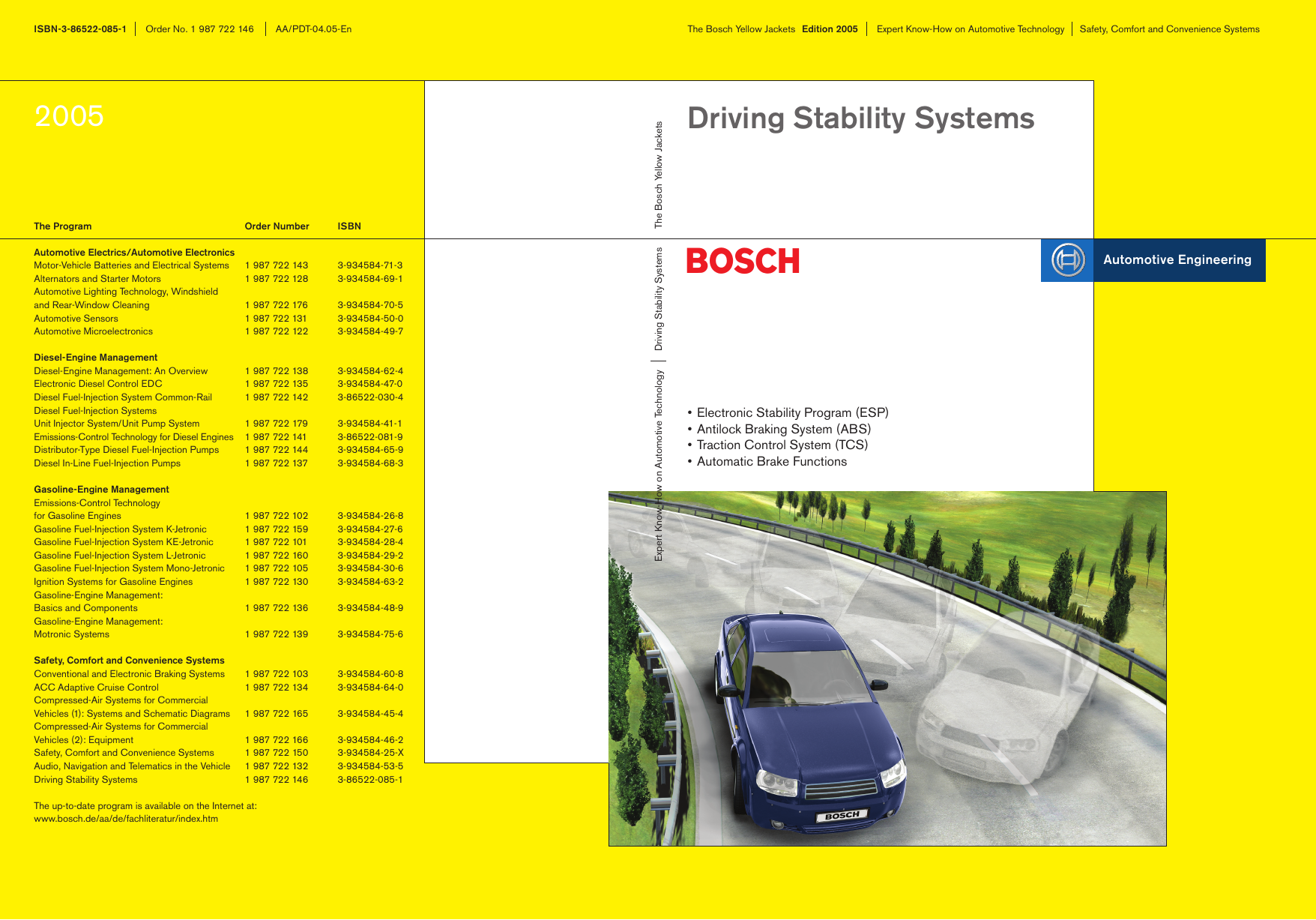
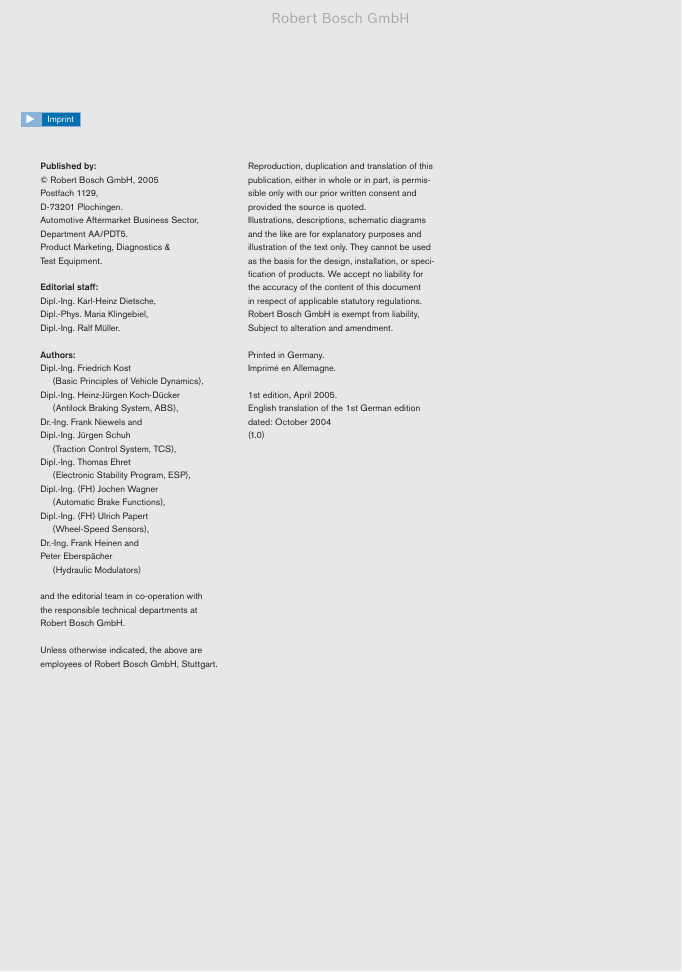

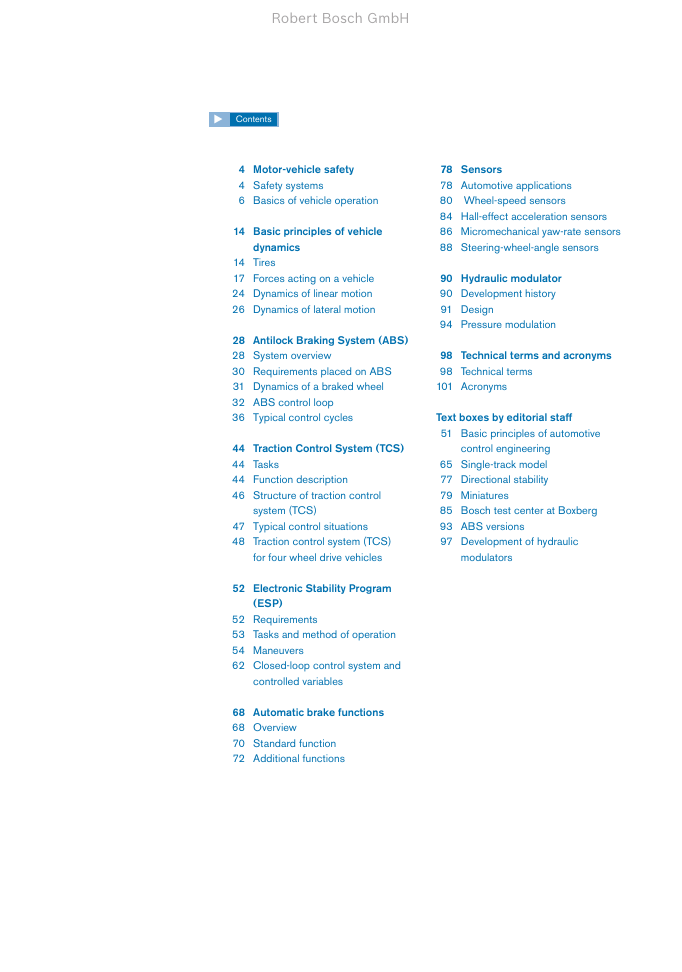

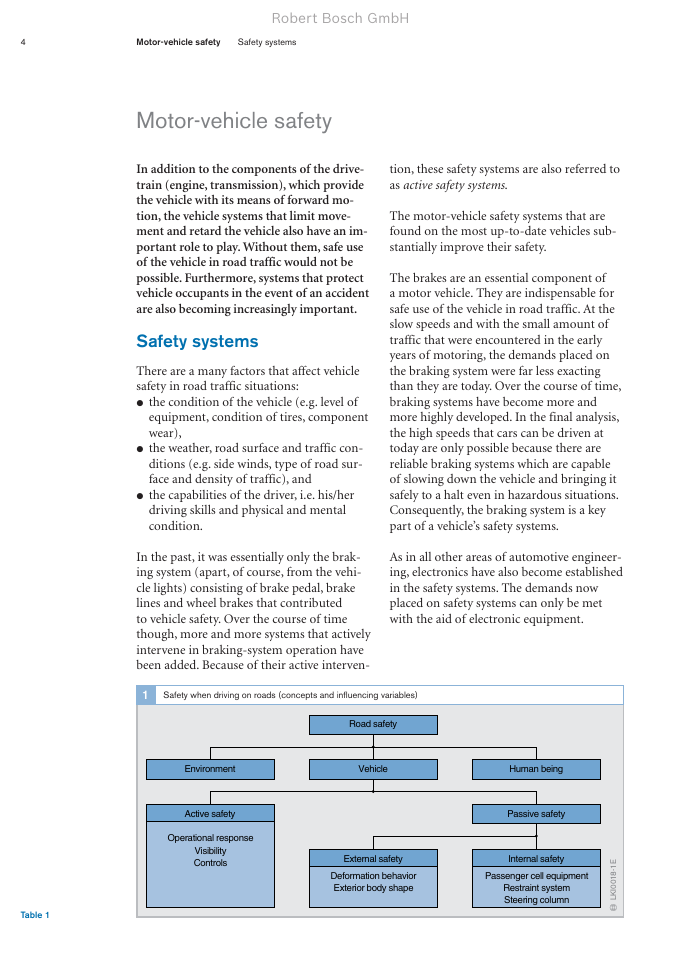

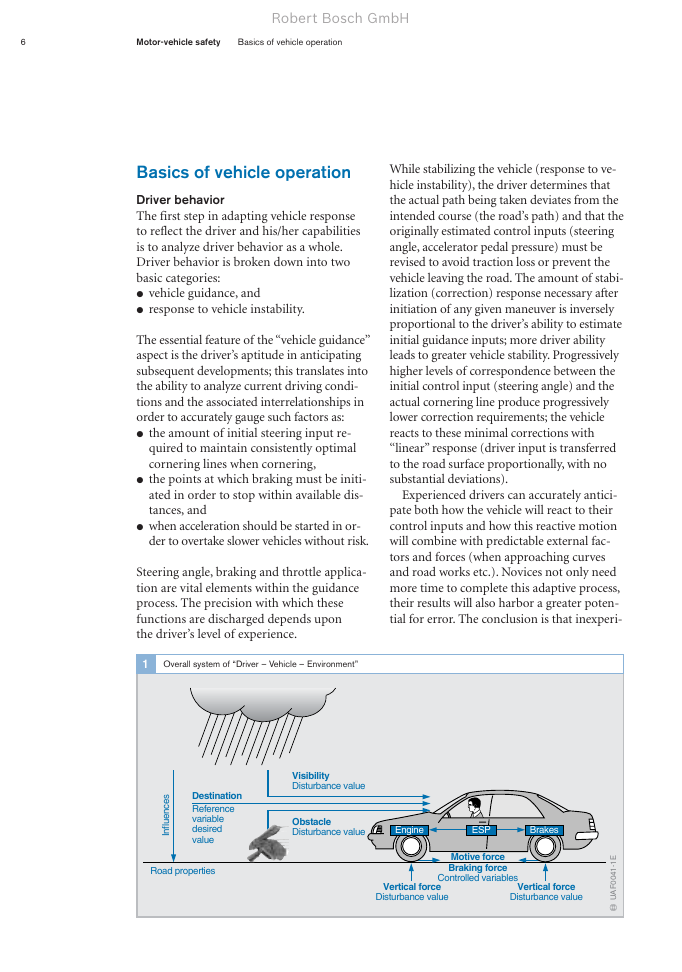








 2023年江西萍乡中考道德与法治真题及答案.doc
2023年江西萍乡中考道德与法治真题及答案.doc 2012年重庆南川中考生物真题及答案.doc
2012年重庆南川中考生物真题及答案.doc 2013年江西师范大学地理学综合及文艺理论基础考研真题.doc
2013年江西师范大学地理学综合及文艺理论基础考研真题.doc 2020年四川甘孜小升初语文真题及答案I卷.doc
2020年四川甘孜小升初语文真题及答案I卷.doc 2020年注册岩土工程师专业基础考试真题及答案.doc
2020年注册岩土工程师专业基础考试真题及答案.doc 2023-2024学年福建省厦门市九年级上学期数学月考试题及答案.doc
2023-2024学年福建省厦门市九年级上学期数学月考试题及答案.doc 2021-2022学年辽宁省沈阳市大东区九年级上学期语文期末试题及答案.doc
2021-2022学年辽宁省沈阳市大东区九年级上学期语文期末试题及答案.doc 2022-2023学年北京东城区初三第一学期物理期末试卷及答案.doc
2022-2023学年北京东城区初三第一学期物理期末试卷及答案.doc 2018上半年江西教师资格初中地理学科知识与教学能力真题及答案.doc
2018上半年江西教师资格初中地理学科知识与教学能力真题及答案.doc 2012年河北国家公务员申论考试真题及答案-省级.doc
2012年河北国家公务员申论考试真题及答案-省级.doc 2020-2021学年江苏省扬州市江都区邵樊片九年级上学期数学第一次质量检测试题及答案.doc
2020-2021学年江苏省扬州市江都区邵樊片九年级上学期数学第一次质量检测试题及答案.doc 2022下半年黑龙江教师资格证中学综合素质真题及答案.doc
2022下半年黑龙江教师资格证中学综合素质真题及答案.doc